Remembering Muncacs
The Carpathian Mountain city was a place where Jews could live without any awareness of non-Jews nearby.
In its thousand-year history, one of the centers of Jewish life in Eastern Europe had many names and many rulers. It was Mukachevo, Mukacevo, Munkatsch and Muncacs, depending on which nation claimed it.
For 18 years, Eugen Schoenfeld, who was born there in 1925, called Muncacs home.
Now 91, Schoenfeld, who for many years led the sociology department at Georgia State University and is a regular AJT columnist, still has vivid memories of Jewish life in the tumultuous years between the world wars.
His recollections of life in Muncacs form a rich legacy of an era when Jewish communal living was at its peak in much of Eastern and Central Europe.
“We were lucky in a sense,” he said. “We were given the political autonomy to organize the Jewish community around the needs of the Jewish people.”
When he speaks of the Holocaust, he speaks from experience, not only of the personal tragedy of the loss of so many friends and family, but also of all that was in Jewish cultural and religious life.
The Jews of Muncacs were heavily influenced by a thriving Hasidic movement. The chief rabbi was Chaim Elazar Spira, the leader of the Muncaser Hasidic community.
When his only daughter married in 1933, 10,000 guests flooded the town, and the government suspended immigration rules for anyone who wished to attend. A Soviet newsreel camera crew from Moscow covered the event.
Muncacs counted numerous followers of the rebbes of other Hasidic families as well. There were sizable numbers of the Belz dynasty, of the Spinka, Zidichov and Vizhnitz families. There was a well-developed network of cheders for teaching the young about the Torah and simple Jewish law.
For older students, the Tiferes Bechorim provided daily classes in Rashi and Torah studies and the finer points of Jewish law in the Gemara and Tosafot. Community mikvahs not only served a religious function, but provided a bath for many community members each week before Shabbat. A network of Jewish charities provided aid to the poor.

There were printing presses for religious works and for the Yiddish newspapers that were published each Friday. The community had nearly 30 synagogues, open to all any time of the year.
“Unlike contemporary American practice,” Schoenfeld said, “no one was ever denied entrance to a synagogue on Rosh Hashanah or Yom Kippur. It was an unheard-of thing, for a Jew to be denied entrance to a synagogue.”
Schoenfeld received a progressive education at the Muncacs Gymnasium, a strong supporter of the Zionist movement. All its classes were taught in Hebrew, and every student had to pass a comprehensive exam conducted entirely in the language to graduate. The school was considered one of the finest Jewish educational institutions of its kind in Eastern Europe
It thrived among the more modern residents of the town despite an order from the Hasidic chief rabbi, who initially excommunicated the teachers, staff and parents who sent their children there.
The center of Schoenfeld’s life was the Great Synagogue of Muncacs, built by Mitnagdim (Orthodox) religious opponents of the Hasidim. It echoed with the voices of magnificent cantorial artists. They included Cantor Yossele Rosenblatt, who went on to enormous success in the United States. In 1927 he appeared in Hollywood’s first modern sound film, “The Jazz Singer.”
Despite its size and sophistication, Schoenfeld remembers his hometown more as a shtetl, a closely knit Jewish community with traditional values, than as a thriving, modern center of 20th century Jewish life.
Although half the town’s residents were non-Jews, the Jewish community created a sense of distance and self-sufficiency. Growing up, Schoenfeld didn’t know a single non-Jewish resident of Muncacs.
“The shtetl was organized around the social condition of that time,” he said. “It was centered around the duties man had toward G-d, the duties men had toward other men and the duties one had in the faith that the Messiah would come one day. These three duties were the three most important duties of life that began in the Middle Ages and continued as the central values of the shtetl.”
Jewish life in Muncacs abruptly ended in the final years of World War II. By the end of May 1944, its 15,000 Jews had been deported to Auschwitz, and the Nazis pronounced the city Judenrein — free of Jews.
Eugen Schoenfeld will discuss his memories of Muncacs with Bob Bahr in a multimedia program, “The Last Shtetl,” at 10 a.m. Sunday, April 23, at Temple Sinai, 5645 Dupree Drive, Sandy Springs.




comments